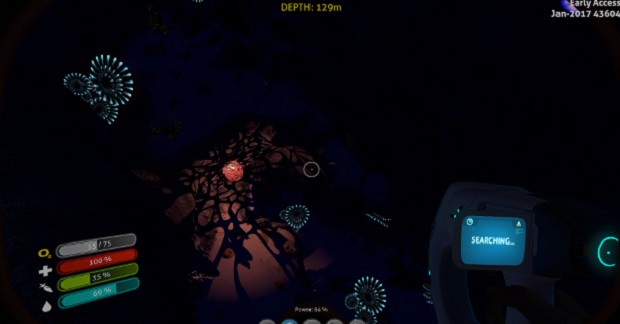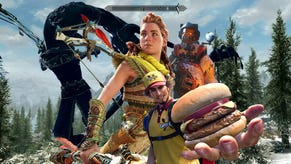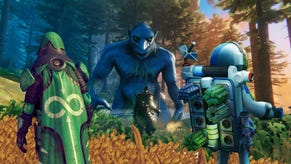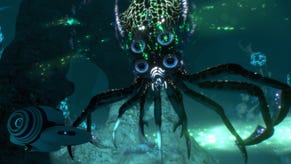Subnautica is secretly a brilliant horror game
It isn't safe to back into the water
Subnautica [official site] seems like a nautical holiday wrapped inside a survival game. Swim around a gentle ocean and meet lots of colourful fish, chill out in an underwater forest, sunbathe on top of a little escape pod – it all sounds very relaxing. Don’t be fooled. Subnautica is, in fact, absolutely terrifying.
I can’t quite remember when I realised that the sea was actually a vast world of horrors. Whenever it was, this realisation was undoubtedly confirmed when I was snorkeling off the coast of Australia in my early teens. I broke the surface of the water to be greeted by blood. So much blood. Not mine, thankfully. It belonged to a man who had bumped into some coral, which proceeded to rip open his leg.
Coral! Nobody expects this of all things to tear chunks out of them, but that’s what you get when you decide to visit the utterly alien sea. In Subnautica, this is even more pronounced because it’s a literal alien sea, an entirely new world, that you’re exploring. You’re not meant to be there and you’re definitely not welcome.
I didn’t begin my extremely distressing adventure feeling unwelcome, however. That’s the first trap that Unknown Worlds Entertainment sets. Subnautica, at first, feels a little familiar. If you squint, it could be Earth, and it seems largely friendly. After the initial shock of the crash landing, it’s all calm waters and vibrant, picturesque reefs. Sure, there’s your typical survival concerns – looking for food, creating drinking water, hunting down the resources you’ll need to feed your flashy 3D printer – but it’s far from stressful.
This is the bit in Jaws where pretty swimmers splash around and have a lark, unaware of the terrors they are about to face. Eventually, the quest to not just survive but thrive pushes you further into the ocean. Into the darkness. Subnautica’s first hint of horror doesn’t appear in those dark places, though. Even the seemingly welcoming shallows hide dangers that get right to the core of some of our most basic fears.
It began when I was chasing a spry little fish, my lunch, but it kept getting away from me. It darted into a cave, and despite the fact that I didn’t have a great deal of oxygen left, I decided to follow, egged on by the dwindling meter that represented my increasingly empty belly. The cave was, in fact, a labyrinthine series of tunnels, spiraling down and down, getting smaller and smaller. I lost the fish almost immediately, but got turned around so quickly that I had no idea where the entrance was. I started to panic.
I’m only a little claustrophobic, but like any reasonable person I’m pretty terrified by the prospect of drowning, dying gasping for breath and clawing at my throat. As I frantically searched for a way out, I could feel the film of sweat between my palm and the mouse growing as I gripped it like a lifeline. I didn’t escape, couldn’t escape, but death came and it felt like a relief, depositing me back in my escape pod no worse for wear. Well, not physically.
I learned a valuable lesson: don’t go underwater spelunking when you’ve got barely any oxygen left. Probably a bit obvious. Other threats are less so. The largest creatures in the starting area are docile beasties that vaguely resemble manatees. One of the reasons manatees are endangered is because they are entirely lacking defences. They don’t have natural predators, aside from the occasional human, so they haven’t really developed any ways to stop us from, often accidentally, killing them. Subnautica’s manatee analogues are a reminder that this is not Earth, and that appearances can be fatally deceptive.
I swam up to one of these lumbering behemoths, and it didn’t seem particularly bothered by my presence, lulling me into a false sense of security. But when I got close enough to touch it, I quickly realised my mistake. A noxious green gas erupted out of its bizarre tail, followed by spore-like orbs. When has green gas or alien spores ever lead to anything good happening? Choking and poisoned, I tried to flee, but I barely made it a metre before dying once again. You can’t trust anything in these waters; everything is a trap. And remember: this is the nice part of the ocean planet.
Tapping into our fear of the unknown is, undoubtedly, the game’s most malevolent and effective trick. Not being able to tell whether a creature is dangerous or not is a persistent concern. Poison-spewing manatees and drowning had left me a bit timid, but it wasn’t until I ventured into the aforementioned forest, full of kelp-like creepvine, that I started to feel truly out of my depth and properly scared.
At the edge of the shallows is this imposing drop, no less intimidating just because you can float. The scale of the expanse in front of me – dark and ominous – made me desperately want to turn back, but I persevered. I had resources to gather. I felt so vulnerable, though, bobbing far from both the water’s surface and the seabed, with nothing to hold onto apart from the fleeting hope that I’d make it out alive. Worse, I was barely able to see more than the shadows of the fish menacingly circling me. I could tell they were big, however, and their movements were undeniably predatory.
Obscuring vision is a prominent tactic in Subnautica’s creepy playbook. It’s most obvious when the sun sets, transforming the ocean into a pitch-black nightmare where all the worst monsters come out to play. More subtle is the use of the scuba mask, which reduces vision just enough so that you never quite feel like you’re seeing the whole picture. It’s a brilliant, nasty trick that isn’t used enough in horror games, but always makes me think of the exceptional Metro series, with its life-saving, claustrophobic gas mask.
The sight of a sea monster – particularly the horrific, gargantuan leviathans – is only slightly less terrifying than the sound they make. It’s like hearing a demonic horn that signals your impending death. As awful as that sound is, it can occasionally be a boon, letting you know something deadly is coming for you, maybe giving you enough time to swim away as fast as you can. If you’re very lucky.
In the early part of the game, before you get your handy vehicles and dangerous weapons, fleeing is usually your only recourse. You’re not the hunter; you’re prey. It’s evocative of the nerve-wracking feeling you get when you’re being hounded by the xenomorph in Alien Isolation. You know you’re outmatched. Unfortunately, this is yet another reminder that you don’t belong. The things chasing you are much better swimmers. Faster and very, very hungry.
These aren’t the scripted, manipulative jump scares or sanity-threatening psychological frights that you find in more overt horror. Subnautica doesn’t bill itself as a horror game at all, in fact. But this manages to make it feel even more threatening. This is nature that’s trying to kill you – primal and elemental and tangible. There are no inner demons to slay; no alien invaders to slaughter. You are the alien invader, swimming around an entire world where you don’t belong. I’m sweating again, just thinking about it.
It’s not safe to go back into the water again. It’s never safe.























